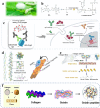Sustainable Materials Enabled Terahertz Functional Devices
- PMID: 40214928
- PMCID: PMC11992292
- DOI: 10.1007/s40820-025-01732-1
Sustainable Materials Enabled Terahertz Functional Devices
Abstract
Terahertz (THz) devices, owing to their distinctive optical properties, have achieved myriad applications in diverse domains including wireless communication, medical imaging therapy, hazardous substance detection, and environmental governance. Concurrently, to mitigate the environmental impact of electronic waste generated by traditional materials, sustainable materials-based THz functional devices are being explored for further research by taking advantages of their eco-friendliness, cost-effective, enhanced safety, robust biodegradability and biocompatibility. This review focuses on the origins and distinctive biological structures of sustainable materials as well as succinctly elucidates the latest applications in THz functional device fabrication, including wireless communication devices, macromolecule detection sensors, environment monitoring sensors, and biomedical therapeutic devices. We further highlight recent applications of sustainable materials-based THz functional devices in hazardous substance detection, protein-based macromolecule detection, and environmental monitoring. Besides, this review explores the developmental prospects of integrating sustainable materials with THz functional devices, presenting their potential applications in the future.
Keywords: Metamaterial; Sensor; Sustainable materials; Terahertz; Wireless communication.
© 2025. The Author(s).
Conflict of interest statement
Declarations. Conflict of Interest: The authors declare no interest conflict. They have no known competing financial interests or personal relationships that could have appeared to influence the work reported in this paper.
Figures








References
-
- H. Wang, F. Zheng, Y. Xu, M.G. Mauk, X. Qiu et al., Recent progress in terahertz biosensors based on artificial electromagnetic subwavelength structure. Trac Trends Anal. Chem. 158, 116888 (2023). 10.1016/j.trac.2022.116888
-
- L. Du, M.R. Molas, Z. Huang, G. Zhang, F. Wang et al., Moiré photonics and optoelectronics. Science 379(6639), eadg0014 (2023). 10.1126/science.adg0014 - PubMed
-
- P. Bawuah, J.A. Zeitler, Advances in terahertz time-domain spectroscopy of pharmaceutical solids: a review. Trac Trends Anal. Chem. 139, 116272 (2021). 10.1016/j.trac.2021.116272
-
- X. Zhang, Q. Xu, L. Xia, Y. Li, J. Gu et al., Terahertz surface plasmonic waves: a review. Adv. Photon. 2(1), 1 (2020). 10.1117/1.ap.2.1.014001
Publication types
LinkOut - more resources
Full Text Sources
